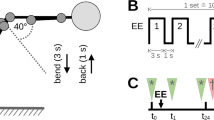Abstract
Background
Delayed-onset muscle soreness (DOMS) occurs after unaccustomed exercise and is particularly associated with eccentric exercise. Previous studies have proposed the use of a single bout of eccentric exercise to prevent the muscle damage subsequent to a bout of eccentric exercise. This study aimed to establish a suitable animal model to evaluate the pain in DOMS and to assess whether low-load eccentric training confers a protective effect against a subsequent high-intensity eccentric exercise bout.
Methods
Thirty-six female Wistar rats were divided into five groups: rats that received muscular compression only (Comp); those that received high-intensity eccentric exercise only (HE); those that received muscular compression at 3, 24, 48, and 96 h after high-intensity eccentric exercise (HE + Comp/3, 24, 48, and 96 h); those that received muscular compression 48 h after a single low-load eccentric exercise (LE); and those that received a week of low-load eccentric training before high-intensity eccentric exercise, which was followed by muscular compression 48 h later (LET). Immunohistochemistry was used to investigate c-fos expression in the dorsal horn of the spinal cord.
Results
For the HE + Comp/48 h rats, the total number of c-fos-positive neurons at the L2–3 segments was significantly greater than that in the Comp and HE rats in the same segments. A week of low-load eccentric training resulted in a decreased number of c-fos-ir neurons relative to that in the HE + Comp/48 h rats.
Conclusions
Muscle tenderness after high-intensity eccentric exercise was evaluated by c-fos expression in the dorsal horn of the rat spinal cord. Using this rat model, the present study clarified that the muscle tenderness following high-intensity eccentric exercise is inhibited by prior low-load eccentric training.






Similar content being viewed by others
References
Armstrong RB. Mechanisms of exercise-induced delayed onset muscular soreness: a brief review. Med Sci Sports Exerc. 1984;16:529–38.
Graven-Nielsen T, Arendt-Nielsen L. Induction and assessment of muscle pain, referred pain, and muscular hyperalgesia. Curr Pain Headache Pep. 2003;7:443–51.
Smith LL. Acute inflammation: the underlying mechanism in delayed onset muscle soreness. Med Sci Sports Exer. 1991;26:542–51.
Asmussen E. Observations on experimental muscular soreness. Acta Rheumatol Scand. 1956;2:109–16.
Newham DJ. The consequences of eccentric contractions and their relationship to delayed onset muscle pain. Eur J Appl Physiol. 1988;57:353–9.
Armstrong RB, Ogilvie RW, Schwane JA. Eccentric exercise-induced injury to rat skeletal muscle. J Appl Physiol. 1983;54:80–93.
Proske U, Allen TJ. Damage to skeletal muscle from eccentric exercise. Exerc Sport Sci Rev. 2005;33:98–104.
Talbot JA, Morgan DL. Quantitative analysis of sarcomere non-uniformities in active muscle following a stretch. J Muscle Res Cell Motil. 1996;17:261–8.
McHugh MP. Recent advances in the understanding of the repeated bout effect against muscle damage from a single bout of eccentric exercise. Scand J Med Sci Sport. 2003;13:88–97.
Nosaka K, Clarkson PM. Muscle damage following repeated bouts of high force eccentric exercise. Med Sci Sports Exerc. 1995;27:1263–9.
Brown SJ, Child RB, Day SH, Donnelly AE. Exercise-induced skeletal muscle damage and adaptation following repeated bouts of eccentric muscle contractions. J Sports Sci. 1997;15:215–22.
Clarkson PM, Tremblay I. Exercise-induced muscle damage, repair, and adaptation in humans. J Appl Physiol. 1988;65:1–6.
Lavender AP, Nosaka K. A light load eccentric exercise confers protection against a subsequent bout of more demanding eccentric exercise. J Sci Med Sports. 2008;11:291–8.
Hunt SP, Pini A, Evan G. Induction of c-fos-like protein in spinal cord neurons following sensory stimulation. Nature. 1987;328:632–4.
Taguchi T, Matsuda T, Tamura R, Sato J, Mizumura K. Muscular mechanical hyperalgesia revealed by behavioural pain test and c-Fos expression in the spinal dorsal horn after eccentric contraction in rats. J Physiol. 2005;564:259–68.
Maruhashi Y, Kitaoka K, Yoshiki Y, Nakamura R, Okano A, Nakamura K, Tsuyama T, Shima Y, Tomita K. ROS scavenging activity and muscle damage prevention in eccentric exercise in rats. J Physiol Sci. 2007;57:211–6.
Molander C, Xu Q, Grant G. The cytoarchitectonic organization of the spinal cord in the rat. I. The lower thoracic and lumbosacral cord. J Comp Neurol. 1984;230:133–41.
Lima D, Avelino A, Coimbra A. Differential activation of c-fos in spinal neurones by distinct classes of noxious stimuli. Neuroreport. 1993;4:747–50.
Peyronnard JM, Charrona LF, Lavoiea J, Messier JP. Motor, sympathetic and sensory innervation of rat skeletal muscles. Brain Res. 1986;373:288–302.
Takahashi Y, Aoki Y, Doya H. Segmental somatotopic organization of cutaneous afferent fibers in the lumbar spinal cord dorsal horn in rats. Anat Sci Int. 2007;82:24–30.
Brushart TM, Mesulam MM. Transganglionic demonstration of central sensory projections from skin and muscle with HRP-lectin conjugates. Neurosci Lett. 1980;17:1–6.
Chen TC, Nosaka K, Sacco P. Intensity of eccentric exercise, shift of optimum angle, and the magnitude of repeated-bout effect. J Appl Physiol. 2007;102:992–9.
Chen TC, Chen HL, Lin MJ, Wu CJ, Nosaka K. Potent protective effect conferred by four bouts of low-intensity eccentric exercise. Med Sci Sports Exerc. 2010;42:1004–12.
McHugh MP. Recent advances in the understanding of the repeated bout effect: the protective effect against muscle damage from a single bout of eccentric exercise. Scand J Med Sci Sports. 2003;13:88–97.
Acknowledgments
The authors thank Ms. Yoko Kasai and Ms. Miyako Shimasaki for skillful technical assistance.
Conflict of interest
The authors declare no conflict of interest.
Author information
Authors and Affiliations
Corresponding author
About this article
Cite this article
Munehiro, T., Kitaoka, K., Ueda, Y. et al. Establishment of an animal model for delayed-onset muscle soreness after high-intensity eccentric exercise and its application for investigating the efficacy of low-load eccentric training. J Orthop Sci 17, 244–252 (2012). https://doi.org/10.1007/s00776-012-0212-1
Received:
Accepted:
Published:
Issue Date:
DOI: https://doi.org/10.1007/s00776-012-0212-1




